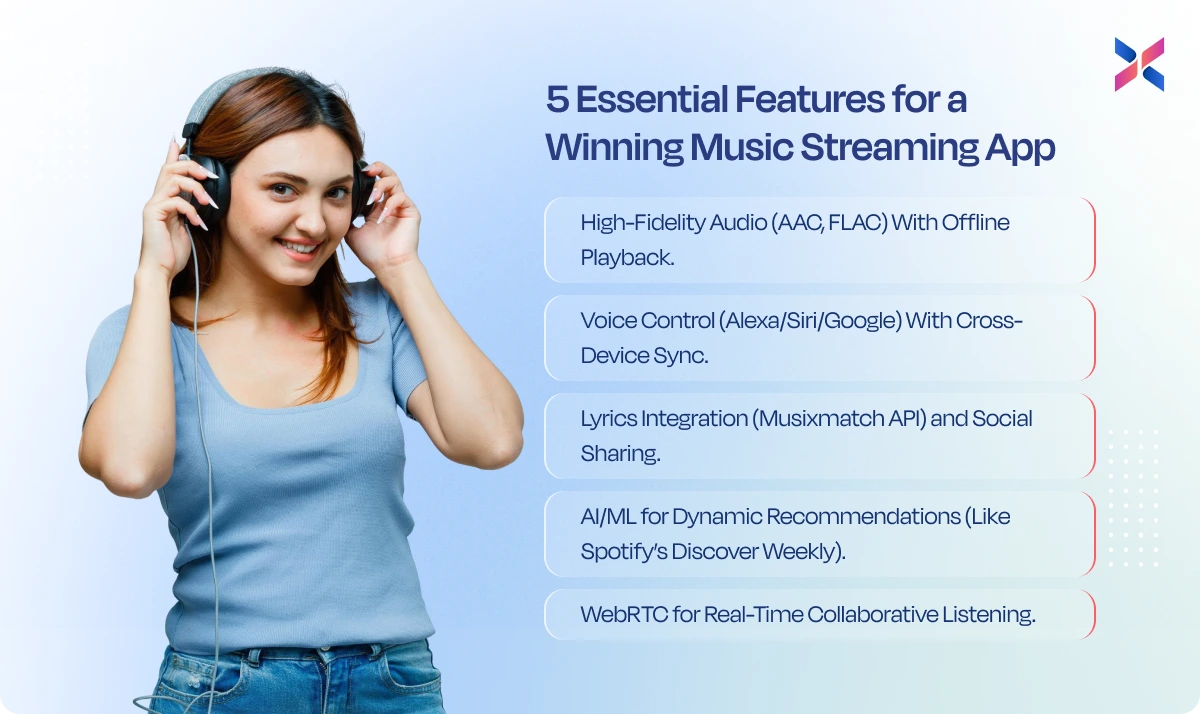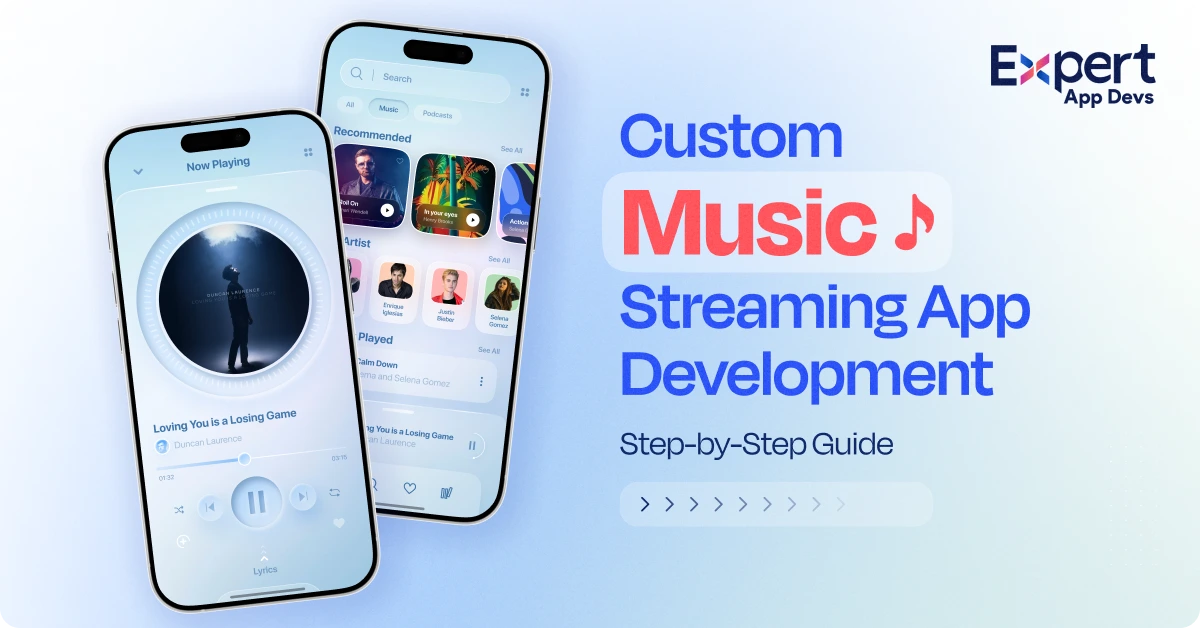How to Build a Music Streaming App: Licensing, Features & Monetization
Are you relying on generic platforms that are unable to scale or stand out? A lot of businesses are sailing in the same boat. With the increasing need for personalized and seamless audio experiences, you can no longer rely on white-label streaming solutions. Why is this the right time for custom music streaming app development?
A surge has been observed in the music streaming app development, with the US markets projected to reach $42.92 billion by 2029 (statista). It is an opportunity too big to miss, and you should make the most of it by planning your app now.
By building a custom music streaming application, you can customize the user experience, integrate advanced features and ensure complete control over branding and monetization.
In this guide, we will take you through all the points to consider when planning music streaming app development from scratch. We will cover the must-include features, licensing needs and challenges to ensure you are fully prepared.
Our guide will help you stand apart in the saturated market and capitalize on the booming audio economy.
Global Streaming Market Trends & User Expectations
Streaming isn’t optional; it is the standard for the audio economy. Music streaming has become a habit for users living in the connected world. On average, Americans stream 75 minutes of music per day. (source: MusicalPursuits)
This indicates a shift in the way people consume music and the need for platforms to deliver consistent and high-quality experiences to users on demand. With numerous users eyeing the platform, there is a huge opportunity for streaming solution providers if they can meet evolving user demands.
With the integration of AI, users need more personalized solutions. They are no longer satisfied by a static playlist; they need experiences that are tailored to their preferences and emotions. Discover Weekly, a feature by Spotify, is one step towards this need. A lot of streaming apps have also created playlists that are in sync with the mood of the user.
There are playlists for workout, road trip and even a sad mood. The ultimate goal is in how users interact with music. It is crucial to introduce seamless navigation and voice control to ensure better experiences. You can also cater to diverse age groups, create a community and promote social sharing for better retention.
Your app should be more than music, delivering a personalized experience and ultimate value to the end users.
Must-Have Features to Create a Competitive Music Streaming App
If you want to stand out in the music streaming space, you need to go beyond the basics for app development. We have identified the core and advanced features that are essential to create a superior experience.

Core Features
Here are the foundational features that can ensure smooth playback with intuitive controls and an extensive listening experience.
#1. High-fidelity audio (AAC, FLAC) + offline playback
Your users want studio-quality audio while listening to their music application. By ensuring your application supports formats like AAC and FLAC, you can offer lossless sound that your users need. Coupled with the offline playback, your users will enjoy uninterrupted music even when the app is in offline mode.
Incorporating this feature, you can justify the premium pricing for your application and improve the monetization methods. This combination of high-fidelity audio with offline listening can deliver compelling value to your customers, thus helping you gain a competitive edge.
#2. Voice control (Alexa/Siri/Google) + cross-device sync
When you integrate voice assistants like Alexa, Siri or Google Assistant, you offer hands-free convenience and accessibility to your users. If you match this with cross-device synchronization, you can switch between devices seamlessly to enjoy uninterrupted music.
It helps ensure continuity in experiences, especially if you have a multi-device household. By implementing these features, you can improve brand loyalty and reduce the churn rate for your streaming application.
#3. Lyrics integration (Musixmatch API) and social sharing
You can add real-time lyrics using APIs like Musixmatch to increase engagement. This is especially useful for users who are learning new languages or karaoke fans. You can also include social sharing features like posting the favorite tracks and adding playlists to Instagram or Twitter to foster virality.
With these interactive elements, you can improve user retention while turning your listeners into brand advocates. You can use entertainment combined with shareable content to increase visibility and relevance of your app in the digital landscape.
Advanced Tech
You must incorporate cutting-edge technologies in your music streaming application to stand out in a crowded market. It can improve personalization and interactivity while ensuring your platform is future-proof.
#4. AI/ML for dynamic recommendations (like Spotify’s Discover Weekly)
By adding AI-backed recommendations to your application, you can transform passive listening into a personalized journey. Machine Learning can analyze the listening habits to suggest new songs, artists and genres that users enjoy.
As a result, the content stays fresh and ensures the users keep returning back. If your algorithm is really good, it can ensure better engagement, which can be converted into a monetization opportunity through targeted upsells.
#5. WebRTC for real-time collaborative listening
This feature can enable real-time peer-to-peer audio streamlining that can enable features like group listening sessions and virtual listening parties. Using this feature, your users can chat live or react to the songs in real-time, even when they are distant.
It can help create an interactive and community-driven experience for your users. with collaborative listening, you can encourage emotional connections and enhance session duration, thus creating a profitable application.
Music Licensing for Streaming Apps: What You Must Know
Working with legal expertise while building the music streaming application can help you avoid lawsuits. They can help you navigate the complexities of rights management and compensate artists well.
Here are all the US-specific laws to consider when ensuring legal compliance of your music streaming application.
#1. RIAA/ASCAP/BMI Licensing Costs
When developing music streaming app in the US, you must get licenses from organizations like RIAA, ASCAP and BMI that can help with recorded music and performance rights. These licenses include per-stream royalties that are between $0.003 to $0.008 per play.
If you don’t get these licenses while developing the application, you may need to pay hefty fines and experience app shutdowns. You can avoid roadblocks by investing in licenses during early stages.
#2. DMCA Takedowns and Copyright Bots
Your platform should have a system for DMCA compliance that can handle copyright takedown requests easily. In some cases, the apps may have automated copyright bots to scan and upload content for infringement.
Using these tools, you can prevent unauthorized use and minimize the legal exposure to enhance the app’s reputation.
Pro Tip: In case of indie content, you must partner with distributors like DistroKid or TuneCore to simplify licensing and broaden the music catalog.
Monetization Strategies for Music Apps That Actually Work
Building your music streaming app doesn’t mean adding great features; it is also about ensuring sustainable profitability. You must introduce the right monetization models that can help you grow your users while ensuring long-term revenue generation.
Here are the top models that you can incorporate into your application.
#1. Freemium (ads + subscriptions)
The freemium model allows you to reduce the barrier to entry, thus attracting a large user base by providing free access with ads. Once the users are attracted to your application, they may upgrade to the premium plan for ad-free listening and offline playback.
With this dual approach, you can monetize from committed and casual users, thus enjoying sustainable growth. With free users, you can optimize ad targeting and refine upselling strategies.
Freemium is the foundation for scalable growth with streaming platforms.
#2. Tiered Plans (student/family bundles)
Tiered pricing can help you cater to different demographics with diverse usage needs, thus helping you boost acquisition and retention. For instance, student discounts can help you entice the younger audiences with limited budgets.
In case of family bundles, you can offer multi-user adoption with a single plan. These models can help you increase the average revenue per user while ensuring a low churn rate. It can also help you improve brand loyalty by offering flexible options that adapt to the evolving user lifestyles.
#3. Ancillary Revenue: NFTs, Merch, Concert Tickets
Music streaming apps can tap into the high-margin revenue streams like concert tickets, artist merchandise and other music-related NFTs. You can even integrate eCommerce and blockchain elements to create a platform that supports artists while enhancing fan engagement.
You can diversify your app income while also positioning your app as a lifestyle application. Ancillary monetization allows you to turn passive listeners into active consumers of your business.
Case Study: How SoundCloud Monetizes Fan-Powered Royalties?
SoundCloud disrupted traditional music streaming to become one of the biggest open audio platforms by incorporating the feature fan-powered royalties. This is unlike what most platforms did, where the artists are paid for individual engagement and not platform streams.
Traditional vs FPR
In the traditional model that follows a pro-rata system, listener subscriptions are pooled and then distributed to the artists who are streaming at the top. This would leave independent musicians with minimal earnings.
SoundCloud decided to revamp this structure by offering a particular fan’s subscription to the artist they listen to most. This ensures a direct connection between the fan and the artist.
In SoundCloud, they calculated the amount of listening time for the particular artist, and divided the revenue from their subscription in that proportion. This created a more transparent model and increased the earnings for the niche creators.
The Impact
This approach ensured a positive monetization impact for the small musicians. They were rewarded for the depth of engagement rather than volume.
It also provided a strategic advantage for the saturated market. It aligned the business model with creator empowerment and their fans’ engagement. This would improve artist retention and enable the fans to support them directly.
Technical Architecture to Scale Your Streaming App
The technical foundation of your music streaming application should be robust, scalable and cost-efficient. Here is a quick tip on how to make smart choices to create growth-driven and performance-oriented architecture.
#1. Backend: AWS Media Services Vs. Google Cloud’s Transcoding
For reliable backend development, you can consider AWS media services and Google Cloud transcoding. With AWS, you get scalable encoding, packaging and live streaming through Media Convert and MediaLive that back your high-volume and live content needs.
Google Cloud enables fast and AI-backed transcoding that is integrated with YouTube-grade infrastructure. You must choose one of the two based on your latency needs, compatibility with the existing ecosystem and budget.
AWS is great when you need feature-rich and custom workflows, while Google Cloud works when you are looking for speed and simplicity.
#2. Low-Latency Streaming: WebSockets + CDN Optimization
When you want to include real-time features like collaborative listening or live events, you can use low latency. WebSockets can offer persistent and bi-directional communication between the server and clients. It reduces response time while ensuring a smooth user experience.
You can connect it with CDN using edge caching and adaptive bitrate streaming for fast content delivery even with traffic surges. These technologies together can reduce buffering and sync the delays to ensure better engagement and user satisfaction.
#3. Cost Estimate: MVP vs. Enterprise
Cost estimates are an important part of your backend and architecture choosing journey. To get started and validate the app idea, you can build an MVP. It can include essential features like search, user accounts and streaming. This will cost you somewhere between $100,000 and $250,000.
At this cost, you can get everything from UI/UX design to backend development and licensing setup for the MVP. In case you are planning to build an enterprise-grade application with AI recommendations and real-time features, you need to invest more than $500,000. You may need to spend additionally for licensing, marketing and maintenance of the application.
By planning for scalability early, you can control long-term costs and ensure a smooth transition from MVP to an enterprise platform.
Security, DRM & Anti-Piracy Must-Haves
You must protect content and user data while building music streaming solutions. By implementing robust security measures, you can prevent revenue loss while enhancing trust amongst artists and listeners.
#1. DRM (Widevine, FairPlay) for Content Protection
Investing in Digital Rights Management will ensure that there are no unauthorized copies of the streamed content being distributed. There are two industry standards concerning DRM solutions, Widevine by Google and FairPlay by Apple. They allow you to encrypt the audio files and enforce licensing rules across browsers and devices.
These technologies ensure you can stream the premium content in a secure fashion. It will safeguard intellectual property and reassure record labels and artists that their content is protected.
#2. 2FA + Biometric Logins to Prevent Account Sharing
When you go with unauthorized account sharing, it can reduce revenue and violate the license agreements. You can implement two-factor authentication and biometric logins like fingerprint and facial recognition. This can increase another layer of security.
With these features, you can verify user identity, limit account misuse and prevent simultaneous logins. Apart from enhancing security, it can improve user trust and protect revenue.
How to Choose the Right Music Streaming App Development Company?
When you choose the right tech stack and development partner, you can ensure successful music streaming app development. Let’s understand how you can align your build approach with business goals and the right team to deliver upon your scope.
Native (Swift/Kotlin) vs. Cross-Platform (Flutter/React Native): What’s Best for Your Use Case
At-a-glance table comparing native with cross-platform approach.
|
Features |
Native (Swift/Kotlin) |
Cross Platform (Flutter/React Native) |
|
Performance |
Top speed and responsiveness |
Slow, improves rapidly |
|
User Experience |
Optimize platform-specific UI |
Consistent, less native-like feel |
|
Development Time |
Long: separate codebase |
Faster, single codebase for platforms |
|
Maintenance |
Expensive: update per platform |
Easy to update across platforms |
|
Use Case |
Best suited for high-performance and complex apps |
Ideal for MVPs and projects with budget constraints. |
Native app development offers superior performance with platform-specific integration. This makes it ideal for feature-specific and long-term app development. You can use cross-platform development to reduce costs and speed up development, which makes it a fit for startups and testing markets.
Vetting a Music Streaming App Developer (Checklist)
Choosing a reliable music streaming app development company is crucial for your app’s success. Here is a detailed checklist to improve decision-making.
#1. Industry Experience
You must look for firms that have a proven track record in music app development or media solutions. They should be familiar with the license requirements, streaming protocols and content management system development for faster development with fewer errors. To check for relevant experience, you should seek examples and case studies of similar projects.
#2. Technical Skill Set
Find teams that are proficient with the technologies you aim to use. For example, if you plan to launch an iOS-first application, you must be well-versed in Swift. Apart from the platform-specific technology, they should also know DRM, CDN optimization and audio processing. With a technically fluent team, you can reduce development risks while enhancing the scalability of the product.
#3. UI/UX Design Capability
You need a strong design team that can help you build a seamless and engaging application. For this, you must review their portfolios to assess their ability that help create intuitive and appealing designs. You must look for user-centric and mobile-first music applications that drive retention.
#4. Agile Methodology and Communication
Choose a company that uses agile methodology for iterative development with fast feedback. It helps with regular updates, clear project management and sprint reviews that ensure complete transparency and reduce scope creep.
#5. Post-launch Support
It is important to ensure reliable support for ongoing updates, bug fixes and scaling infrastructure. That’s why you need a company that provides post-launch maintenance, SLA and DevOps support. This will ensure a long-term partnership that goes beyond the initial release.
#6. Legal & Compliance Awareness
It is crucial to choose a development team that is well-versed in licensing, copyright and data privacy regulations. Look for someone who can help you avoid legal pitfalls while ensuring minimal risk and full app protection. They should also help reduce user data mishandling.
Conclusion
Building a successful music streaming application goes beyond playlists and playback. You must work through complex licensing frameworks and advanced features like AI-backed recommendations and infrastructure.
You need to consider everything from high-fidelity audio to real-time social features for secure DRM and optimized monetization. It is crucial to align all aspects with your users’ expectations and market trends.
Choosing the right tech stack with a development partner is equally important for long-term app success. Are you ready to transform your idea into an outstanding streaming application? Book a free consultation with our developers who specialize in end-to-end streaming solutions.
FAQs for Music Streaming App Development
Q1. What licenses do I need to launch a music streaming app?
Ans: You need a public performance license from either ASCAP or BMI, along with a mechanical license from MLC or Harry Fox Agency to legally stream music online on your music streaming app. If you aim to stream full tracks, you need a master-use license from the record labels.
Q2. How much does it cost to develop a music streaming app?
Ans: The cost of developing an MVP with core features for music streaming app is anywhere between $100,000 and $250,000. If you plan to develop a full-scale enterprise application with AI integration and global scalability, it will cost more than $500,000. The final cost depends on the feature set, platform choice and licensing fees.
Q3. Which features make a music app competitive?
Ans: Features like live streaming, offline playback, AI-backed recommendations and voice control can increase engagement and help you app stand out amidst competition.
 Jignen Pandya
Jignen Pandya





